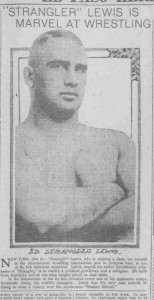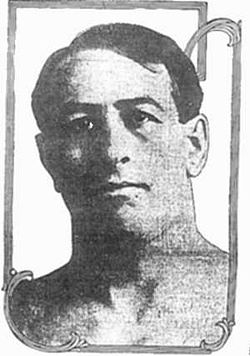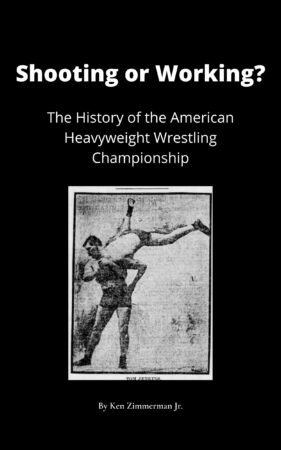Lewis Wins American Title
Prior to wrestling in Kentucky in the early 1910s, wrestling fans knew Ed “Strangler” Lewis as Bob Fredrichs. Born Robert Friedrich in Nekoosa, Wisconsin, Lewis made his professional wrestling debut in 1905, while still only 14 years old.
Kentucky promoters thought Bob Fredrichs too plain, so Lewis chose his new name as an homage to fellow Wisconsin native and original “Strangler,” Evan Lewis. Lewis billed himself from Lexington, Kentucky for the next decade.

Young Ed “Strangler” Lewis from the Public Domain
On September 18, 1913, Dr. Benjamin Roller, the current American Heavyweight Wrestling Champion, arrived in Lexington to defend his championship against Lewis. The wrestlers treated fans to an impressive exhibition.
When Lewis entered the ring at 8:50 p.m., the fans cheered his entrance and treated him like the hometown hero. The reporter did not give exact attendance numbers but said “a large crowd with a surprising number of women fans” attended the card. During this time, a large crowd may have been one to five thousand people.
The ring announcer introduced Lewis at 202 pounds compared to Roller at 217 pounds. Later in his career, Lewis weighed as much as 260 pounds at five feet, ten inches tall. Lewis showed up in peak condition for this match and pressed the action from the beginning to the end.
After five minutes of tying up and bulling Roller around the ring to start the match, Lewis switched to the back for a body hold. Lewis took Roller to the mat and transitioned to a full-Nelson. Before Lewis could lock the hold in, Roller slipped out and jumped to his feet.
Roller tried to throw Lewis, who stopped the attempted throw with a leg grapevine. After reversing out of Roller’s attempt, Lewis tossed Roller over his head. Lewis attempted a scissors hold and hammerlock combination, but Roller escaped. Lewis attempted a three-quarter Nelson, but Roller slipped out again.
When Lewis attempted another full-Nelson, Roller grabbed Lewis’ arm and executed an arm roll. Lewis rolled onto his shoulders for the first fall, which surprised the fans, Lewis and maybe Roller. Roller took the first fall in twenty-two minutes.
Roller scoring a quick fall with such a basic move caused some fans and reporters to question whether the men worked this match or were engaged in a contest. I also suspected Lewis and Roller worked the match. However, the outcome of the second fall leaves me unable to make a firm decision on whether the match was a work or a contest.

Dr. Benjamin Roller in 1911 (Public Domain)
Lewis pressed the action again during the second fall. Roller did secure a waist hold on Lewis. Roller could not turn him to the mat though. Roller pushed Lewis around the ring until Lewis broke the hold.
Roller attempted several half-Nelsons, but Lewis shook off every attempt. Lewis secured his own waist hold and took Roller to the mat.
Roller stood back to his feet, while trying to break Lewis’ grip, but each time, Lewis took him back down. After fifteen minutes of this treatment, Roller started showing the effects of the frequent takedowns.
As Roller visibly fatigued, Lewis took the opportunity to secure a leg scissors around Roller’s waist. Lewis squeezed for several minutes until he forced Roller to submit. Lewis won the second fall in fifty-eight minutes.
Roller’s seconds helped him to the dressing area, where two local surgeons, who the athletic commission assigned to the event, examined him. Both physicians agreed that Lewis’ scissors broke one of Roller’s ribs.
The doctors notified the commission representative that Roller could not continue. Roller forfeited the final fall and match to Lewis due to injury. Lewis won his first professional wrestling championship.
In the ring, Lewis proved to anyone foolish enough to challenge him that he possessed an extraordinary set of catch-as-catch-can wrestling skills. Lewis transitioned from wrestling contests to working matches during the 1910s. Lewis even willingly dropped the world title in the 1920s because he knew if his opponent did not want to return the favor, Lewis would beat the man legitimately.
Lewis and Roller may have worked this match, but Roller’s injury did put doubt in my mind. In 1913, it is unlikely two surgeons would risk their professional reputations by passing off a fake injury.
Lewis now held his first championship. How long would he be able to keep it?
You can leave a comment or ask a question about this or any post on my Facebook page or Twitter profile.
Sources: The Lexington Herald (Lexington, Kentucky), September 19, 1913, p. 1 and 3


